Having a pond in your yard or garden is a beautiful addition that not only adds to the beauty of your home, but it promotes biodiversity and encourages other wildlife. However, a backyard pond can become a mosquito trap during the summer months–standing water attracts mosquitos. These incredibly annoying insects will call your pond home and are incredibly difficult to eliminate completely. So, what’s the solution? Read on to find out about the ten best pond fish that eat mosquito larvae and keep your yard pest-free!
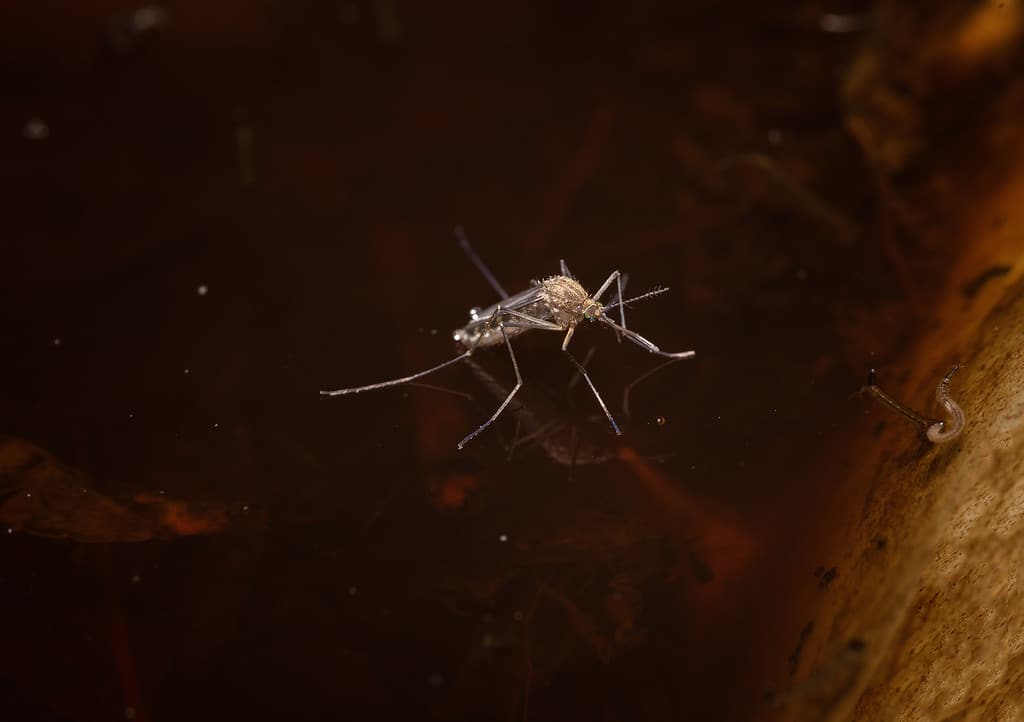
Mosquitos are an annoying summertime pest that can take over your backyard pond.
©T O/iStock via Getty Images
1. Mosqutiofish (Gambusia affnis)
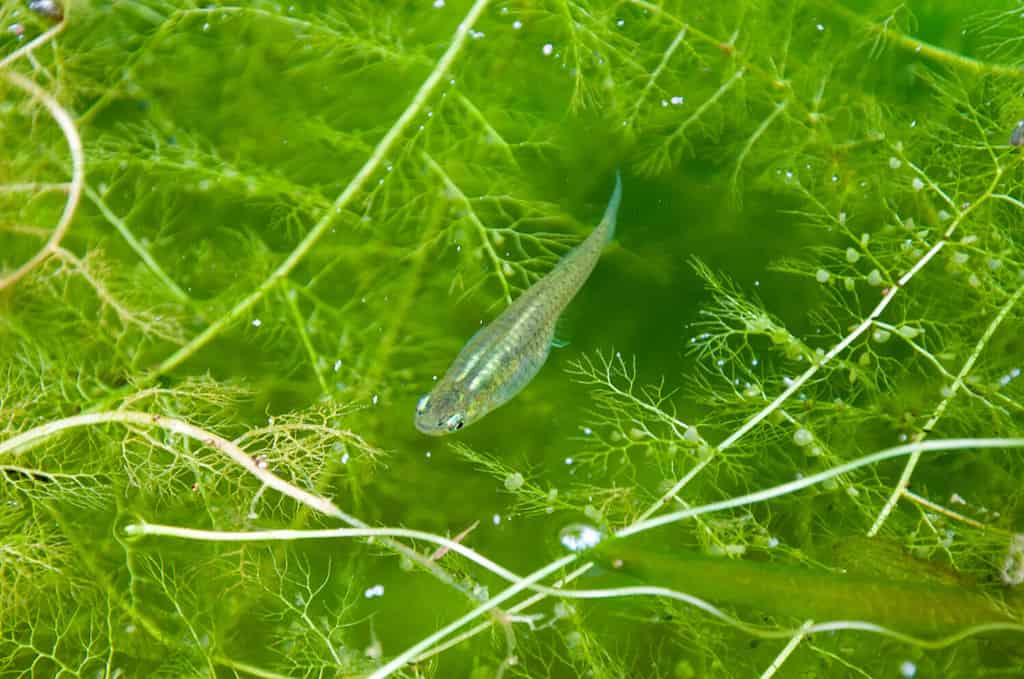
Mosqutofish are a great mosquito deterrent–it’s all in the name!
©Lorenzo Sala/Shutterstock.com
Description
When looking to rid your garden of mosquitos, mosquitofish are a perfect solution. It’s all in the name! These small fish are found naturally all throughout the southeastern parts of the United States, where it’s humid and a place where mosquitos thrive. However, they’ve been found all over the world now as an introduced species to help with mosquito problems in other places too. On average, these fish can live anywhere from 2 to 3 years.
Appearance
Mosquitofish are small fish that have a grayish color about them with black spots. Females can get up to 2.5 inches in length, and males about 1.5 inches. Mosquitofish mouths are pointed upwards in order to make it easier for them to feed from the water’s surface. Also, these tiny yet tough fish don’t lay eggs: instead, they give birth to energetic young during the spring and summer months and can have upwards of 100 offspring every six weeks.
Habitat and Care
Mosquitofish do really well in a variety of environments. They prefer vegetated, quiet sources of water, like streams and rivers. More often than not, they are found in either still or slow-flowing water sources. When introducing mosquitofish into your pond, make sure that the pond is 18 inches deep at a minimum and has plenty of sunlight. If there are other larger fish in your pond, set up a couple of different hiding spots for your mosquitofish. During the winter, mosquitofish will move to the bottom of the pond and will come back up when the temperature gets warmer.
Diet
As far as feeding these fish, ensure that there’s plenty of vegetation (but don’t overdo it) and they will be self-sufficient. Introducing them to a well-established pond is the best way to do it, as there will be plenty of natural food sources like bacteria and algae. However, if it’s a newer pond, make sure you provide supplemental feeding as the natural food sources are not established yet. Once some time has passed, encourage them to move towards the bacteria and algae, and eventually the mosquito larvae.
2. Koi Carp (Cyprinus carpio)
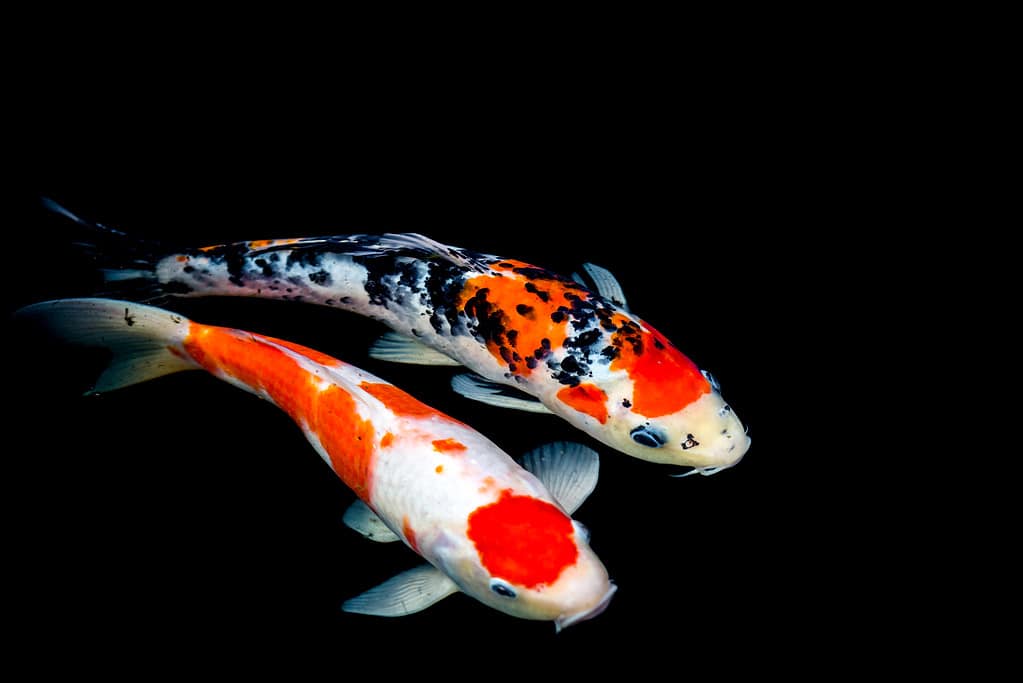
There are hundreds of different kinds of
koi fish
in the world.
©Jerawat Supajirakit/iStock / Getty Images Plus via Getty Images
Description
Koi are some of the most magical fish out there–they are shrouded in mythology and lore that dates back several centuries. They are native to Asia and Central Europe and can now be found in freshwater ponds and water sources all over the world. They are known for their long lifespans–koi fish can live anywhere between 25 and 40 years!
Appearance
These fish are derived from the carp family. These mystical fish are strong and bulky, on average weighing about 35 pounds. They can grow to be 36 inches long. Koi are known for their colorful appearance–some may look the same, but can be a completely different variety of fish! A female koi fish will lay hundreds of eggs in a single spawning episode.
Habitat and Care
Koi fish do well when they can rely on a balanced environment. They need partial shade, but never total shade. Your koi pond should get some direct sunlight as this makes the fish happy but also the plants in your pond need the sunlight in order to grow and provide food for them. Additionally, the pond should be three feet deep at a minimum. This allows the temperature in the pond to vary, but not fluctuate too much. As far as care for your koi and koi pond, make sure it stays clean. Of course, keep toxic cleaning chemicals out of the pond. Make sure that it’s clear of all debris that may land in the pond, like leaves and sticks. Koi are not high-maintenance fish, but they do require a level of cleanliness that other ponds don’t need.
Diet
Koi fish are very adventurous eaters, mostly eating anything and everything they can fit in their mouths. They eat large amounts of mosquito larvae from the water surface of the pond they reside in, but they will need to have a well-balanced diet. Having another larva-eating fish in the koi pond is a great way to help your koi have a well-balanced diet so that they aren’t relying just on mosquitos. They eat a variety of other things, like insects, plants, crustaceans, and more.
3. Bluegill (Lepomis macrochirus)

The bluegill fish is known for its distinct color way and it’s stripes that line the top of its body.
©iStock.com/Dewitt
Description
Bluegill is another famous mosquito-eating fish that makes a great addition to your pond. They are found in freshwater sources all over the United States and have even started appearing in other parts of the world. Often, bluegill is placed in ponds as food for larger fish, like largemouth bass. Bluegill lives for about 5 to 6 years on average.
Appearance
These fish are identifiable by their blue-green hue and yellowish underside. Around their dorsal fin and gill cover, they have a darker color spot. They have a small, compressed, round body that has six to eight stripes running along its body. Bluegill also has a very distinct small mouth. In some cases, bluegill appears to be even colorless sometimes. They grow to be 6 to 8 inches, and weigh less than half a pound!
Habitat and Care
When stocking your pond with bluegill, make sure you leave plenty of aquatic plants in the pond. They love to hide in between these plants. Additionally, bluegill thrives in warm ponds that have a gravel or sandy bottom. These fish reproduce frequently–a female bluegill can lay upwards of 60,000 eggs!
Diet
Bluegill are hungry fish! When the food supply is plentiful, they can eat up to about 35% of their body weight! They are far from picky eaters, too. Bluegill fish eats anything it can. Their diet consists of insects, algae, water plants, and even eggs of other bluegill and amphibians. In addition, bluegill will sometimes even eat other fish!
4. Bass (Micropterus salmoides)

Bass is a staple in fishing culture throughout North America.
©Daniel Estabrooks / CC0 – License
Description
Bass is found naturally in North America in northern Mexico and central and eastern United States. Now, they can also be found in other regions of North America in different sources of freshwater. Bass can live between 10 and 15 years on average.
Appearance
Female bass are larger than male bass. On average, they weigh up to 22 pounds and are about 30 inches in length. The body of a bass is a distinct gray to an olive greenish color, with a yellowish-to-white underside. Black spots and splotches are sprinkled over their body, forming a horizontal line across the fish. Female bass have anywhere between 2,000 to 10,000 eggs when laying.
Habitat and Care
Bass fish require deep ponds–about 3 to 6 feet deep. The larger pond allows them more space to move about and to grow. The pond also needs to be stocked with an abundance of food, as they eat a lot of different things. Additionally, the waters should be as clear as possible, so a clean pond is necessary. Keep an eye on what kinds of fish you’re putting in the pond with bass–they will eat it if they need to!
Diet
When bass are smaller, they feast on mainly insects and larvae. As they mature and grow larger, they go after larger prey–other fish like bluegill, minnows, and more. Mature bass will still snack on mosquito larvae as they find it while hunting prey within the pond.
5. Goldfish (Carassius auratus)
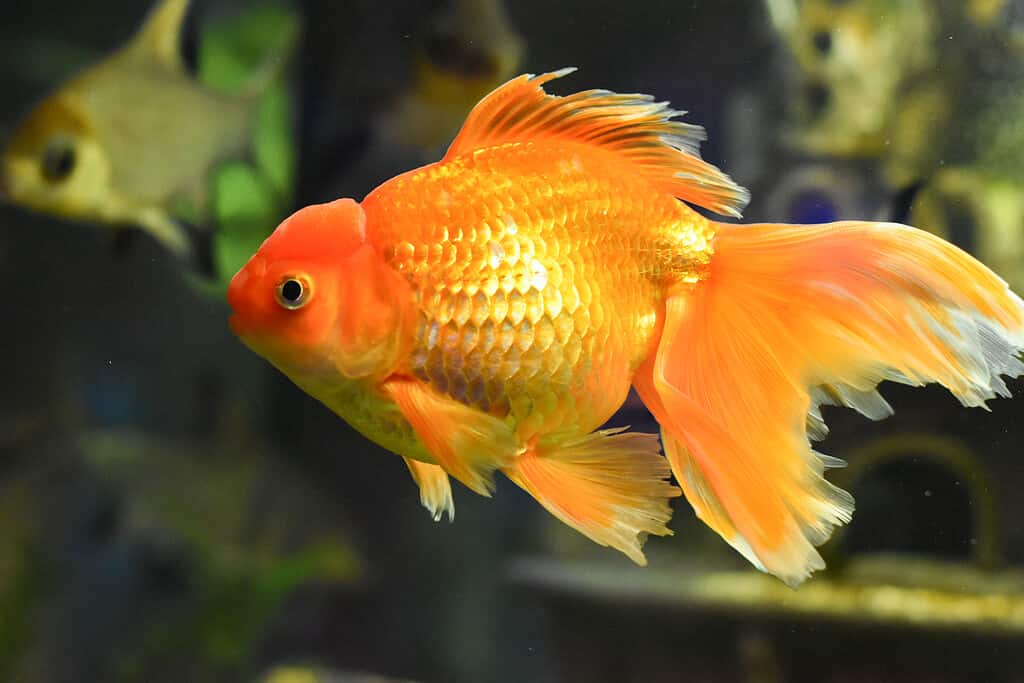
There are many different kinds of goldfish in the world now.
©Julia Vashurina/Shutterstock.com
Description
Native to East Asia, goldfish are now found all throughout the world in ponds and aquariums. Goldfish are considered an ornamental fish, meaning that they are kept in home aquariums for their beauty. Goldfish are also great to have in the pond to fend off mosquitos!
Appearance
Over the course of centuries, goldfish have experienced a very select breeding pattern resulting in over 125 different species. Naturally, they are a greenish-brown color, but now can be found with many different patterns. When taken care of properly, goldfish can grow to be about a foot long and live between 10 and 20 years. Goldfish also breed fairly often–between 2 and 3 times a year. A female goldfish lays about 1,000 eggs at a time in ideal conditions.
Habitat and Care
The pond for goldfish should be at least 40 inches deep. Goldfish are social creatures, so when you introduce them to your pond, start with at least five goldfish. It’s recommended that there are 264 gallons of water per five goldfish, so make sure you plan accordingly. While goldfish are tough fish that don’t require a lot of direct care, the most important thing is regulating the water temperature in the pond. Try to keep it fairly consistent so it doesn’t fluctuate too much, which would harm the fish.
Diet
Goldfish eat insects, algae, and small aquatic plants, in addition to mosquito larvae. You can also supplement their diet with a specific goldfish feed that gives them all the nutrients and vitamins they need.
6. Guppies (Poecilia reticulata)
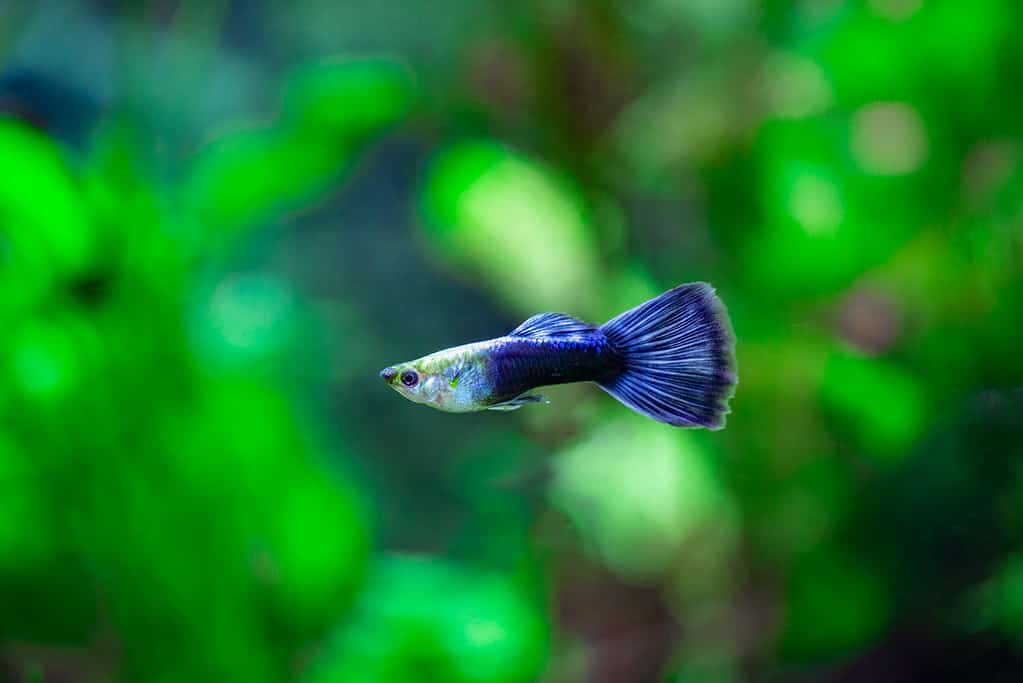
Guppies are also called the million fish, because they often swim in large groups.
©Boban_nz/Shutterstock.com
Description
Guppies are a natural phenomenon in the Caribbean and in northern South America and are now found all over the world. They are a popular staple in ponds and home aquariums.
Appearance
While they are relatively smaller fish (male guppies grow to be 1.5 inches long, females 2 inches), they are tough. They are very colorful and have many unique characteristics per fish. The average guppy lives around 2 to 3 years. These fish also reproduce frequently, female guppies give birth to 80 guppies on average.
Habitat and Care
Guppies are extremely adaptable fish and do well in most environments. While they prefer warm waters, they can survive in lakes, ponds, rivers, streams, and even sewers and ditches. Additionally, they can learn new environments well, making it a great addition to your backyard pond. When it gets cold out, consider bringing your guppies inside or warming the water–they don’t do super well when it gets cold out, as they live closer to the surface of the water. Finally, guppies get along with most other non-aggressive fish species, making it a good addition to your pond.
Diet
Female guppies eat a lot more than their male counterpart; the latter typically is not very active. However, these fish prefer mosquito larvae and eggs and will prioritize that over other food sources, like algae and insects.
7. Catfish (Siluriformes)

Catfish
are named for their cat-like sensory whiskers.
©Alauddin Abbasi/Shutterstock.com
Description
Catfish are a global species–they are found on every single continent in the world, except Antarctica, where it’s too cold for them. While they’re considered predator fish, they play a small role in large sources of water. They live from 5 to 20 years on average. Also, a fun fact: catfish are mostly nocturnal creatures!
Appearance
They are a very recognizable species: the whiskers on catfish (hence the name) act as a sensor for them. Catfish are labeled bottom-dwellers, meaning that they rake up the ground of a body of water while looking and scavenging for food. Also, catfish lack scales–instead, their body is covered in mucous. Finally, in terms of their size, they are very versatile. They range from less than 2 inches in length to a whopping 15 feet, sometimes weighing upwards of 600 pounds! Annually, catfish lay between 3,000 and 4,000 eggs.
Habitat and Care
While there are a few varieties of catfish that live in saltwater, most live in freshwater sources. They prefer warm water ponds with plenty of shade. They tend to stick to the bottom of the pond and feed on anything that they can scavenge here.
Diet
A catfish diet ranges from crustaceans to mosquito larvae, eating mostly anything they can dig up and find.
8. Golden Orfe (Leuciscus idus)
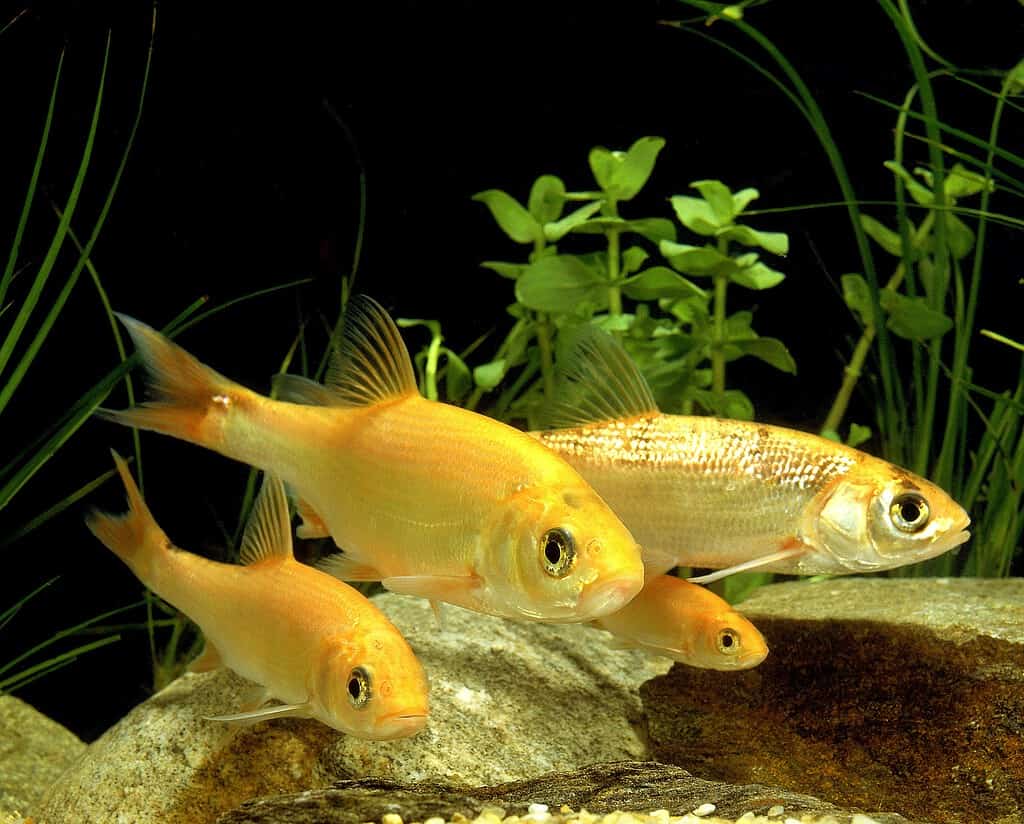
Golden orfes are a very unique-in-appearance fish.
©slowmotiongli/iStock via Getty Images
Description
Golden orfe fish are found throughout the lakes and ponds of Europe and extends into western Siberia. They should be kept with fish that are about the same size, like koi and larger varieties of goldfish. This is so they don’t try to eat the smaller fish, even though they are known for being friendly fish. They often swim in small groups of six to seven other golden orfes. In captivity, they can live more than 20 years.
Appearance
They are beautiful fish, often having a reddish-gold or orange-gold color and a lighter belly. They grow rapidly and get up to 15 to 20 inches in length. On average, they weigh about 4 pounds. Golden orfes reproduce very infrequently, only laying eggs in large ponds with ideal conditions. When all requirements are met, female golden orfes can lay upwards of 115,000 eggs, although young golden orfes have a low survival rate.
Habitat and Care
Each golden orfe fish needs 264 gallons of water, meaning that your pond needs at least 1,584 gallons to keep your fish happy as they like to be in groups of six. During the cold months, golden orfes will move deeper into the water, closer to the ground. Make sure your pond is at least 5 feet deep in order to prevent a complete freeze. Finally, golden orfes require a high-oxygen pond, so plant plenty of aquatic plants to ensure the health of these beautiful fish.
Diet
Golden orfes are a predator, often hunting smaller fish. They target insects as well, like mosquito larvae and beetles. Sometimes, you can witness this fish leaping out of the water to catch a mosquito flying above the water’s surface. Golden orfes are a great addition to your pond to help take care of your mosquito problem, with visual results!
9. Minnows (Phoxinus phoxinus)

These small fish move in groups of hundreds.
©slowmotiongli/iStock via Getty Images
Description
Minnows are fish found naturally all throughout the United States. They are small, easy-to-spot fish that only live about 2 or 3 years in total.
Appearance
They are a dark olive color with a yellowish-white underside. Minnows are also recognizable by their upturned snout and rounded fins. In addition to these distinct characteristics, you can tell it’s a minnow if it is about 2 to 3 inches in length. Adult female minnows tend to be slightly larger than their male counterpart, but not by much at all. Female minnows also can reproduce anywhere from 16 to 26 times per season, laying around 400 eggs each time.
Habitat and Care
Minnows require at least a foot of water in order to live comfortably. Additionally, they need things to hide under–logs, plants, and rocks are good things to have in your backyard pond for most fish in general. Minnows are resilient fish, as they can live in a variety of different aquatic environments. From high-temperature water to low oxygen levels, they can live in most kinds of environments.
Diet
A singular minnow can eat a lot of food in a day. Sometimes, a minnow can eat 65 mosquito larvae in just a day! They don’t limit themselves to just larvae though, and also will eat mosquito pupae as well. In addition to targeting all things mosquito, minnows snack on algae, waste from ducks, some kinds of crustaceans, and bacteria. They are good at keeping your pond clean. Be careful though if you’re introducing them to your pond, and don’t accidentally pair them with a predatory fish!
10. Common Pleco (Hypostomus plecostomus)

The common pleco is a member of the catfish family.
©Joan Carles Juarez/Shutterstock.com
Description
The common pleco fish is in the world’s largest catfish family, the armored catfish. While they can be found naturally in South America, the common pleco has been found in Panama and Costa Rica as well. They can be a bit aggressive with other pleco fish once they’ve reached adulthood. On average, they live about 10 to 15 years.
Appearance
This fish grows to be about 2 feet long. They appear almost squished at first glance but are just wide fish. They are covered in black spots on top of a golden-brownish body, giving it the appearance of zig-zags covering its body. It’s also difficult for this species of fish to breed in captivity because they need about 100 to 200 gallons of water in order to do so.
Habitat and Care
Unlike some of the other fish on this list, the common pleco likes quick-flowing water and streams. However, they also do well in quiet ponds. These fish enjoy hiding though, so make sure your pond is stocked with plenty of hiding spots, like logs, rocks, and driftwood. Finally, the common pleco needs good water circulation in order to be a happy member of the pond.
Diet
The common pleco is another bottom feeder, scavenging and hunting along the bottom of the pond for food. They go after mosquito larvae and other insects, in addition to algae and plants. They don’t eat other, smaller fish, so it’s safe to mix the pond.
All of these different kinds of fish make great additions to any pond and will help take care of your mosquito problem during the hot, humid summer months. Make sure you double-check which fish do well together and which don’t, and that you build your pond for your fish. Enjoy your mosquito-free backyard!
The photo featured at the top of this post is © paulacobleigh/ via Getty Images
Thank you for reading! Have some feedback for us? Contact the AZ Animals editorial team.






